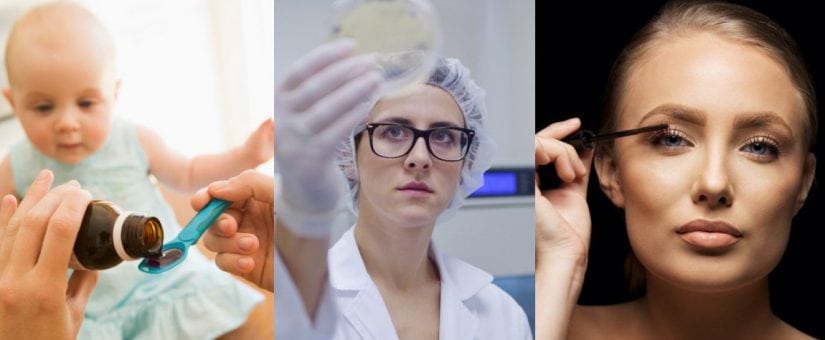An antimicrobial or preservative is defined as a chemical agent that will kill or inhibit the growth of microorganisms. Common antimicrobials utilized in drug, OTC, cosmetic, and personal care products include parabens, alcohols, and quaternary ammonium compounds.
Antimicrobial Effectiveness Testing (AET) also known as Preservative Efficacy Testing (PET) is microbial challenge methodology performed to assure the preservative in a product, or the antimicrobial action created by the properties of a product, is sufficient to combat the introduction of microorganisms.
There are multiple methods available for performing this testing including, USP <51> Antimicrobial Effectiveness Testing, ISO 11930 – Evaluation of the Antimicrobial Protection of a Cosmetic Product, and Personal Care Products Council Methods M-3 to M-7.
Antimicrobial Effectiveness Testing – An Invaluable Product Development Tool
Antimicrobial Effectiveness Testings are performed to help determine the safety of sterile, multi-use drug products subjected to repeated withdrawal of dosage, such as cough syrup, as well as personal care and cosmetic products which are used multiple times during the product life-cycle. Repeat usage of products such as lotions in tubs, aqueous makeup formulations, and eye and lip area cosmetics, can potentially introduce microorganisms via the consumer.
To determine whether a product requires an AET a microbiological risk assessment is performed to discover if the product is susceptible to microbial growth. Product pH, water activity or the preservative action of a product’s raw materials often naturally prevent microorganisms from thriving, eliminating the need for preservatives. If a product demonstrates an environment conducive to microbial growth, preservatives are needed to sustain the safety of the product and subsequently, an AET evaluation must be performed to verify the effectiveness of the preservative.
Since AETs attempt to evaluate the performance of the preservative during the entire duration of consumer use, AETs are often included in stability study protocols. AETs are often performed at the initiation of the stability study and at the final time point of the study, to prove that the antimicrobial is effective for the entire shelf-life of the product. Additional time points may be added during the stability study to generate more conclusive data.
Use an Experienced Lab to Generate Reliable Results
AETs are performed by challenging the product with a panel of microorganisms to verify the preservative’s efficacy against possible contamination agents. A typical study may include gram-positive cocci, gram-negative fermentative bacilli, gram-negative non-fermentative bacilli, yeast, and mold. A panel following this model could be comprised of Staphylococcus aureus, Escherichia coli, Pseudomonas aeruginosa, Candida albicans, and Aspergillus brasiliensis. Organisms known to present a particular danger to a product type, organisms harvested from a manufacturing environment, spore-forming bacilli or others of interest, may also be included in a study to provide pertinent information about the product formulation.
After inoculating the product with the individual microorganisms, periodic testing is performed to evaluate whether the preservative is achieving the desired kill effect. Standard methods recommend testing on day 7, day 14 and day 28, but additional time points may be included as appropriate. The key is to maintain a similar pattern of testing in order to compare test results against other samples or product formulations. For research and development purposes an abbreviated study of 7 or 14 days may be executed to develop a baseline or preliminary indication of preservative efficacy. The methods referenced here all provide criteria for determination of preservative effectiveness based on a log reduction of each of the microorganisms introduced to the product. While the level of a preservative must be sufficient to achieve the desired log reduction, it must not reach a level harmful for human use. As noted in USP Chapter <51>, “(a)ll useful antimicrobial agents are toxic substances. For maximum protection of patients, the concentration of the preservative shown to be effective in the final packaged product should be below a level that may be toxic to human beings based on the recommended dosage of the medicinal product.”
For most formulations, a one-time neutralization study must be performed prior to, or concurrent with, the AET study. A neutralization study determines what neutralizing steps should be taken to allow for the necessary recovery of the challenge organisms at each time point of the study. Neutralization steps may involve adding a chemical neutralizer or diluting the product.
Due to the complex nature of the neutralization, inoculation, and recovery steps of an AET, it is imperative to utilize a qualified laboratory with experience in successfully performing AET studies.
The lab should be familiar with microbial recovery, growth promotion of the microbiological media used in the study, and the proper calculations required to ascertain levels of log reduction. A microbiologist with experience performing AETs will be able to provide effective interpretation of the data generated.
Valuable data gathered from AET studies provide insight into the product formulation as well as helping assure the safety and efficacy of the product.





